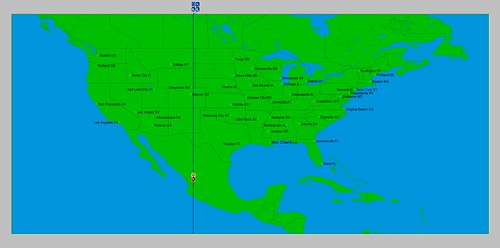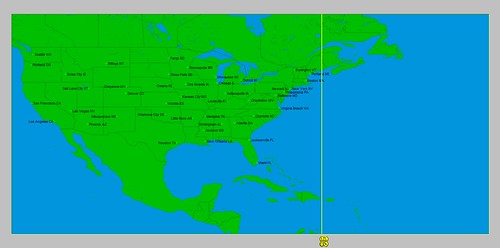Forecast
October 21-25, 2012
Cooler and stormy around the 21st. The Sun's parallel and trine to Neptune around the 23rd should increase southerly air flow and temperatures with perhaps mild or foggy conditions. Then, on the 25th when the Sun conjoins Saturn, things turn stormier most likely due to a cold front.
Results
The general idea of the forecast-- cooler and stormy conditions preceded by a southerly air flow bringing rising temperatures--was fulfilled. Here's a quote from The Weather Channel posted on October 21st.
"A boundary between mild air streaming northward through the Midwest and Ohio Valley and cooler air lurking over the Upper Midwest and northern Plains will be the battleground for some showers and storms on Monday (Oct 22)."
Then on the 23rd, The Weather Channel reported that a strong cold front was then poised to move through the region on the 24th through the 27th. Behind the front temperatures tumbled 20 to 40 degrees.
The Weather Channel map below is for the 24th and shows the cold front and stormy conditions.

The next forecast was also for the Plains and Mississippi Valley area.
Forecast
November 1-2, 2012
Saturn now moves closer to the Mississippi Valley and receives an adverse aspect from Mars. This should result in atmospheric disturbance over the eastern Plains and Mississippi Valley.
Results
This forecast found its fulfillment in a quick moving disturbance that brought some rain showers from Missouri to Ohio on November 3rd. Some light snow and wintry precipitation also was experienced across parts of eastern North Dakota and northwestern Minnesota.
The following Weather Channel map is for November 1st and shows a low pressure over Missouri.

The next forecast was for the West Coast and was issued on August 15, 2012.
Forecast
November 1-3, 2012
A front or storm systems enters the area.
Results
Western Washington and northwest Oregon experienced some rain showers on November 2nd and 3rd. The Weather Channel map below is for the 2nd and shows the front entering the West Coast.

The next forecast appeared in the same post.
Forecast
November 4-6, 2012
Southerly winds bring increasing temperatures.
Results
Temperatures did increase but not exactly because of southerly winds. In this case the winds were northwest winds which brought warm, dry air to the West Coast. Accuweather headlines for Nov. 3rd stated Record-Breaking Heat Returing to Southern California. They also pointed out that very warm temperatures would persist until the 6th. The Accuweather map below shows the warm up.

The last forecast was for the eastern U.S., posted on September 9th.
Forecast
November 9-11, 2012
The transit Sun triggers Venus and Mars which is known to increase temperatures but also carries the potential for storminess throughout the eastern section of the U.S.
Results
The warmth described in the forecast materialized over the eastern U.S. on the weekend of the 10th and 11th. The Weather Channel reported that temps were from near average to 18 degrees above average. There was also showery rain from central and western Upstate New York to Virginia preceded by gusty southerly winds on the 11th.
Testing Astrometeorology Part 2
Hurricane Sandy Fulfills Long-range Weather Prediction!
Testing Astrometeorology Part 1
Fall Weather 2012: Eastern U.S.
Fall Weather 2012: New England
Fall Weather 2012: Central U.S.
Fall Weather 2012: The U.S. West Coast
Mars Conjunct Saturn August 15, 2012
Jupiter-Neptune and Heavy Rain
The Solar Eclipse of November 13, 2012
Long-range effects of the May 20, 2012 Solar Eclipse
Long-range effects of the May 20, 2012 Solar Eclipse Part 2
Hurricane Season 2011 Forecast Results
Hurricane Risk-Management
New Weather Alternative Website
Overview of UK Winter 2012-13
The Winters of 2011-14
Fulfilled Long-range Forecasts for Hurricane Season 2010
Introduction to the Weather Alternative




































